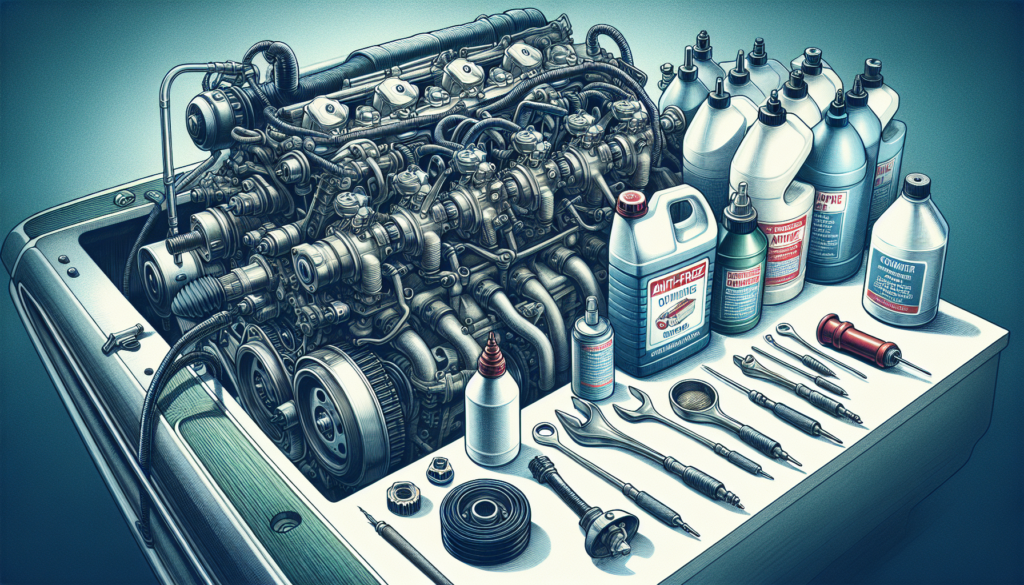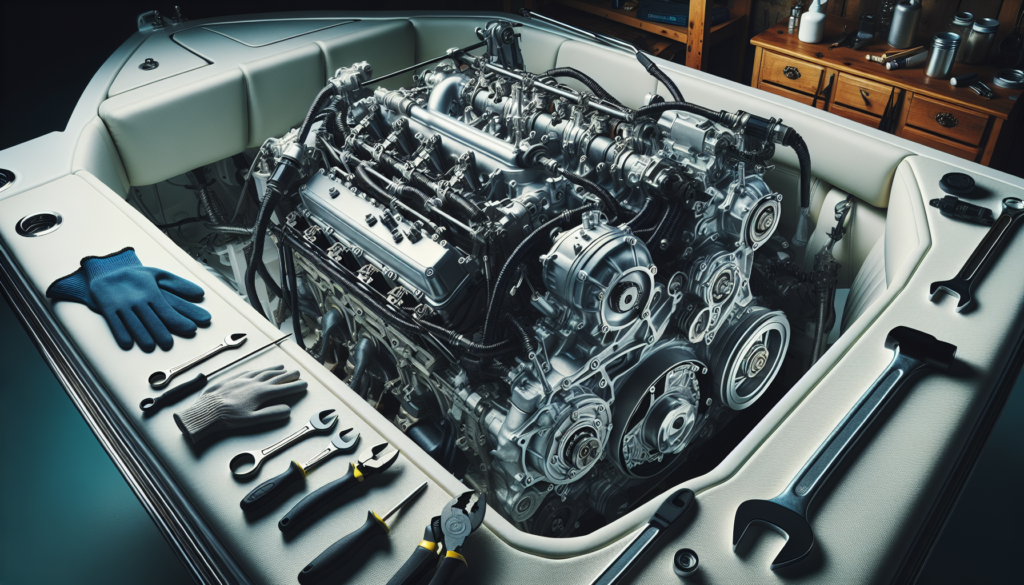As the chill of winter approaches, the time has come for you to safeguard your cherished vessel by winterizing your boat engine for off-season storage. Think of it as tucking in your boat for a long winter’s nap. Your thorough preparation now can ensure a smooth sail when you hit the water next season. This article serves as a detailed guide, leading you step-by-step so you can effectively protect your boat engine against the harsh winter elements and be ready to set sail when warmer days return.

Understanding the importance of winterizing your boat engine
As a boat owner, it’s your responsibility to not just use your boat, but to also take care of it. One key aspect of this care involves winterizing your boat engine when you’re not planning to use it for a while. This goes beyond just making sure your boat is ready to go when warm weather returns. There’s a lot more to it, as you’ll soon find out.
Reasons for winterizing a boat engine
Why should you bother winterizing your boat in the first place? The simple answer is that winterizing a boat engine protects it from the damaging effects of freezing and severe cold temperature. Like it or not, these conditions can take a toll on your engine, particularly when it’s not in use.
Potential damage from not winterizing your boat
Think you can skip winterizing and get away with it? That’s a risky approach, to say the least. Not winterizing your boat engine can lead to a variety of potential problems. For instance, any remaining water in the engine can freeze, expand, and cause cracks or other damage. Corrosion is another common issue, especially in inboard engines.
How neglecting winterization affects engine performance
Even if your boat engine seems to come through the winter without any visible damage, not winterizing can still affect engine performance. It can degrade lubricants, clog the fuel system, and cause a decrease in overall engine efficiency and power. Bottom line: You may end up spending more time and money fixing these issues in the springtime.
Gathering necessary tools and supplies
Before you start the process of winterizing your boat engine, you’ll need to get your hands on some tools and supplies. These are critical for not just ensuring a job well done, but also protecting your engine in the process.
Tools needed for boat engine winterization
The tools you need for winterizing your boat engine can vary depending on your boat and engine model. However, some of the most common tools include a marine engine flushing kit, a wrench or socket set, a screwdriver, a fuel stabilizer, antifreeze, and a bucket.
Necessary cleaning supplies
You’ll also need some cleaning supplies, for both the engine and other parts of your boat. An engine degreaser is a must, as well as a hull cleaner for the exterior of your boat. Don’t forget about some rags or cloths for wiping things down, too.
Locating and acquiring engine-specific additives and fluids
Different boat engines require different fuel and oil additives for successful winterization. You’ll need to consult your engine owner’s manual or a marina to figure out exactly what you need.
Cleaning the boat engine
Before you get started with winterizing, your boat engine needs to be clean. This not only makes it easier for you to work, but also helps the winterization process to be more effective.
Proper engine washing techniques
Cleaning a boat engine isn’t as simple as hosing it down. The engine should be warm, but not hot, when you start the cleaning process. It’s also a good idea to disconnect the battery before starting, for safety reasons.
Cleaning products safe for boat engines
As mentioned before, a degreaser is your best bet for cleaning a boat engine. Spray it on, let it sit (according to the manufacturer’s directions), and then scrub with a brush or cloth before rinsing.
The importance of a clean engine before winterization
Why bother cleaning the engine before winterizing? A clean engine is easier to work on, plus it helps to spot any potential problems. Moreover, it helps your anti-corrosion treatments to work better.
Draining the boat engine
Draining water from the boat engine is an essential step during winterization process.
Identifying and accessing the boat’s drain plugs
Most boat engines have multiple drain plugs that need to be removed for draining. Consult your boat’s manual or use a guide that’s specific to your engine model to find these plugs and figure out how to remove them.
Proper draining techniques
Draining the boat’s engine is relatively straightforward; you just need to make sure to capture the drained fluid in a suitable container. Once all the plugs are removed, allow adequate time for the engine to fully drain.
Why draining the engine is essential
Draining is vital because it removes any water that could potentially freeze and cause damage to your boat’s engine over the winter. Not draining could be a costly mistake, so make sure to take the time necessary for this critical step.

Changing the engine oil
Changing the oil is a necessary part of winterizing your boat. Fresh oil can protect your engine’s internal components from corrosion during storage.
Choosing the right oil for your boat engine
Depending on your boat’s engine, it may require a specific type or grade of oil. Always consult your boat’s owner’s manual and stick to the recommended oil for your engine.
Steps for changing boat engine oil
To change the engine oil, you can either use an extract pump through the dipstick tube, or you can drain it from the oil pan. Once the old oil is removed, realign the drain plug and refill the oil to the specified level.
Ensuring a proper oil change
Remember, a proper oil change means completely draining the old oil and fully replacing it with new oil. Be sure to check your oil level before storing your boat for the season to ensure it’s ready to spring back into action.
Adding antifreeze to the boat engine
Antifreeze is essential for protecting your engine from freezing temperatures.
Selecting the appropriate antifreeze for your engine type
When it comes to engine antifreeze, the type of engine you have will determine the kind of antifreeze you need. Most often, a non-toxic propylene glycol antifreeze is recommended for boat engines.
How to add antifreeze to a boat engine
To add antifreeze, first, locate the water inlet, then connect a hose or funnel to the inlet, and slowly pour in the required amount of antifreeze. It’s essential to follow the manufacturer’s instructions on the amount and concentration of antifreeze.
The role of antifreeze in winterization
Antifreeze plays a vital role in winterization, providing essential protection to your boat’s engine over the cold winter months. The antifreeze itself does not freeze, protecting the engine components from freezing and expanding, which could result in severe damage.

Preparing the fuel system
The fuel system is another critical part of your boat that needs attention before the winter season.
Filling up the gas tank
Before storing your boat, fill up the fuel tank to prevent condensation from forming in the tank over winter. Condensation can lead to water getting mixed with fuel, which can cause severe engine problems.
Adding a fuel stabilizer
After filling up your tank, add a fuel stabilizer. This helps to prevent the fuel from going bad during storage. After adding the stabilizer, run the engine for a few minutes to make sure it’s distributed throughout the fuel system.
The role of a clean and prepared fuel system in winterization
A clean and well-prepared fuel system is essential to protect your boat during winter storage. It ensures the fuel remains fresh and keeps the engine ready for the spring boating season.
Disconnecting the battery
This is a crucial step, and often the most overlooked, in the winterization process.
How to properly disconnect a boat battery
First, you need to disconnect the negative terminal before the positive terminal to prevent a short circuit. Ensure the battery is fully charged before being disconnected to avoid damage related to battery discharge.
Where to store boat battery during off-season
The battery should be stored in a dry, temperate place where it won’t freeze. Remember, cold temperatures can be harmful to batteries, so take precautions when storing them during the off-season.
Why it’s important to disconnect the battery
Disconnecting the battery before storage can prevent any potential electrical problems and help extend the battery’s life. A connected battery can slowly drain over the winter, leading to a flat battery in the spring.

Covering and storing the boat
The final step in the winterization process involves covering your boat and finding suitable storage.
Choosing the right boat covers
A good quality boat cover protects your investment from dust, snow, rain, and UV damage. When selecting a boat cover, go for one that is breathable and water-resistant.
How to properly cover a boat for winter
When covering your boat, ensure that it’s completely dry. Cover it tightly to avoid any gaps where water or snow could get in and make sure it’s secured to avoid being blown off by strong wind.
Finding an appropriate storage space
The perfect storage space for your boat during the off-season is somewhere that’s dry, well-ventilated, and out of direct sunlight. If possible, consider indoor storage as it provides additional protection against harsh weather conditions.
Maintaining the boat throughout off-season
Just because your boat is stored and covered does not mean you can forget about it until spring.
Regular checks on the boat during off-season
You should check on your boat regularly throughout the winter to ensure the cover is secure, check for any leaks, and ensure the battery is still fully charged.
Addressing any off-season issues promptly
If you notice any issues during your check, address them immediately. Early detection and resolution can prevent small problems from becoming significant issues that could interfere with your plans for boating season.
Keeping boat in prime condition for next boating season
Winterization is all about protecting your boat during the off-season, so it’s in prime condition for the next boating season. By following these tips, you can ensure your boat is ready when you are.
Remember, failing to adequately winterize your boat can result in expensive repair costs come springtime. It’s worth the time and effort to protect your investment, so you can enjoy many more seasons out on the water.

